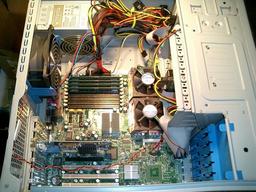
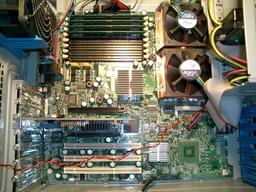
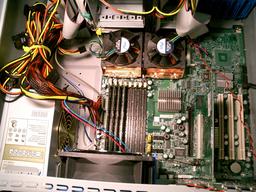
Goal: to determine the performance limits and usability of certain Linux distributions on scientific computation workstations.
Method: we put together a test box, load it with three versions of Linux, and benchmark the CPU/memory performance.
We had to determine first a hardware configuration that can be a
good candidate for our new scientific computation workstations or
nodes of parallel clusters. The criteria for picking the hardware
are:
Lifetime longer than 4 years in poorly ventilated, overheated spaces, with unreliable power feed.
Low Yearly Cost of Ownership (YCO)/performance ratio, with slight emphasize on performance. To calculate YCO, we assumed that the history of the brand is a good indicator of the new component characteristics and reliability.
The following configuration was preferred:
|
Motherboard |
Supermicro X6DAE-G2-O Dual Intel® 64-bit Xeon Support, up to 3.60 GHz, 800 MHz FSB Intel® E7525 (Tumwater) Chipset Up to 16GB DDRII 400 SDRAM Intel® 82545GM Single-port Gigabit Ethernet Controllers 2x SATA Ports via ICH5R SATA Controller 1 (x16) & 1 (x4) PCI-Express, 1x 64-bit 133MHz PCI-X, 2x 64-bit 100MHz PCI-X, 1x 32-bit 33MHz PCI AC'97 Audio, 6-Channel Sound |
|
CPUs (2x) |
Intel Xeon "Irwindale" Processor BX80546KG3000FA 3.0GHz, 800MHz FSB, 2M Cache, PGA4, HT, EM64T, XD, Active HS |
|
RAM (4x) |
Kingston KVR400D2S8R3/512 512MB, DDR2 DIMM, 400MHZ, REG ECC, CL3, Single Rank, 1.8V |
|
Hard drive |
Western Digital Caviar SE 120GB ATA-100 WD1200JB Average Seek Time - 8.9 ms Spindle Speed - 7200 rpm Buffer Size - 8 MB |
Images of the system (click to enlarge):
While the main focus of our tests was to compare results obtained on
the same hardware, for reference purpose we included some of the
interesting results obtained on other computers (a P4 2.6 GHz 800FSB and a dual Xeon 2.8 GHz 533FSB).
We considered these platforms as viable cheap second choices for
scientific workstations and parallel cluster nodes.
A Linux distribution has to be picked. We used the following criteria optimized for maximum productivity:
Large amount of pre-compiled supported software packages included in the distribution.
Long lifetime: security upgrades offered by vendor and/or community for at least 3 years.
Relatively new but stable versions of software packages, a well polished user interface, good integration and compatibility with commercial software (e.g. matlab, mathematica, maple).
None of these kernels will recognize correctly the amount of L2 cache of the Xeon "Irwindale" CPUs. While /proc/cpuinfo in Redhat 7.3 and SUSE 9.1 report 0KB of L2 cache, SUSE 9.2 finds 16 KB (out of 2048 KB).
As expected, Redhat 7.3 has problems configuring the gigabit Ethernet adapters and the sound built into the Supermicro X6DAE-G2-O motherboard. Everything else seems to work fine.
STREAM benchmark measures sustainable memory bandwidth.
Linux/Unix nbench (based on BYTE's benchmark) measures the performance of CPU, FPU, and memory (mostly cache).
While the main focus of our tests was to compare results obtained on
the same hardware, for reference purpose we included some of the
interesting results obtained on other computers running Redhat 7.3.
These computers are a P4 2.6 GHz 800FSB and a dual Xeon 2.8 GHz 533FSB.
We considered these platforms as viable cheap second choices for
scientific workstations and parallel cluster nodes.
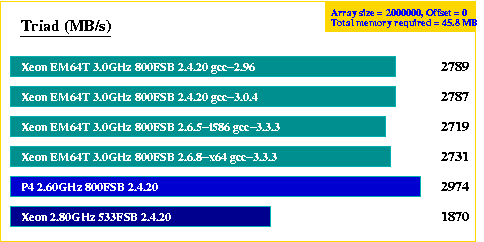
See our complete STREAM bandwidth results and details.

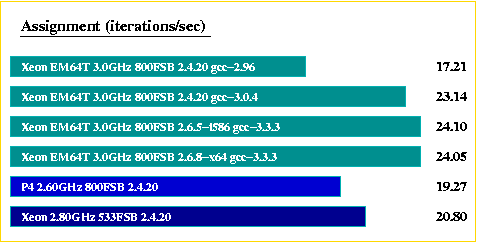
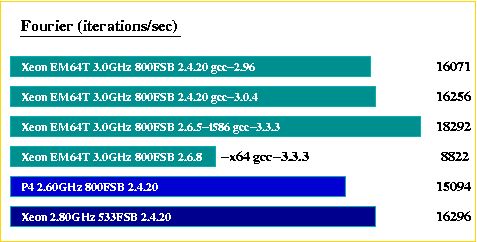
See our complete NBENCH-BYTE results, observations, and benchmark meaning.
Performance for 64-bit OS can be as much as twice faster to twice slower than the 32-bit version on the same hardware. Test a typical job to see if 64-bit brings any improvement.
New Xeons EM64T 800 FSB do not generally bring enough performance improvement to justify upgrades of older 533 FSB parallel cluster nodes.